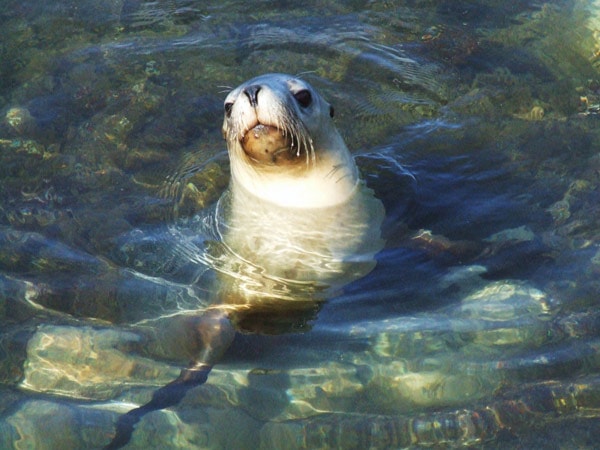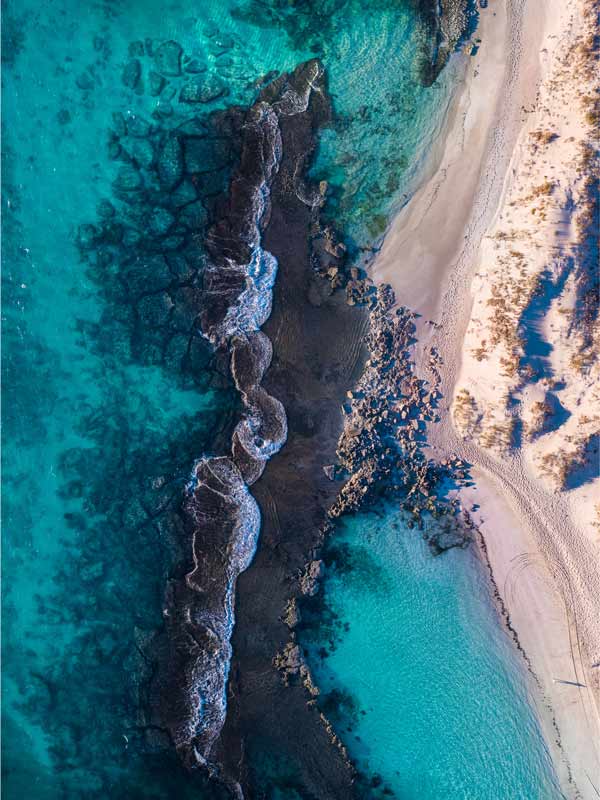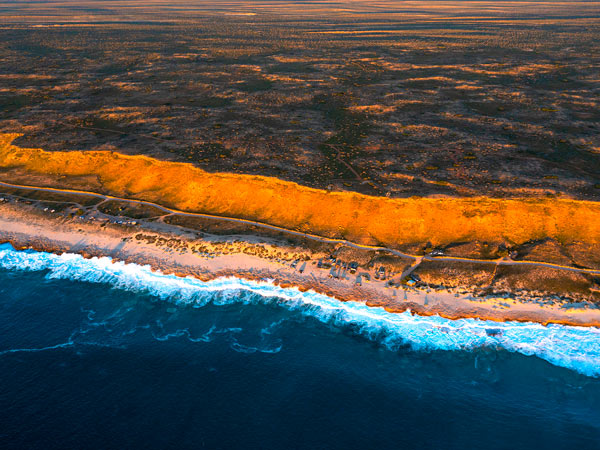June 14, 2022
![]() 9 mins Read
9 mins Read
As I slip into the open ocean, my heart pounds. I’m searching the depths for a mighty creature. But I’m searching too deep and now, looking along the glassy surface, I see a fin is advancing towards me. I pop my head back under and startle; a wide, open mouth is just metres from me and I swim-scurry aside. The harmless whale shark is eight metres long, and my brain struggles to compute its sheer size and ethereal presence.
Rejoining the rest of the swimmers in my group, I fin alongside this muscular, mottled being, while a photographer snaps photos for an identification database.

“As I slip into the open ocean, my heart pounds. I’m searching the depths for a mighty creature.”
Climbing back on our boat, we’re all euphoric. Every one of us had come to Exmouth on the Coral Coast (1250 kilometres north of Perth) hoping to see a whale shark, and the experience has exceeded my expectations. But while I’m here, I’m discovering that the whole Coral Coast is an immersive marine bonanza. With its sparse population and pristine waters, the Coral Coast is a place to get wind-messed hair and salty skin, and taste lobster fresh from the sea. It’s a place to play didgeridoos with saltwater people. It’s a place to dive right in.
I’d started my journey further south, joining a five-day eco-cruise to the Houtman Abrolhos Islands, 60 kilometres west of Geraldton. It’s a stark and windy place, with 122 islands. It’s also the southern limit for coral reefs in the Indian Ocean, and one of Australia’s most important seabird nesting areas. We meet fishermen who live in colourful shacks while they’re catching Western rock lobsters (Australia’s first certified sustainable fishery). Our skipper has a special lobster licence too, and we chow down on the prized crustaceans.

There is an abundance of sea life in the waters off the Houtman Abrolhos Islands. (Image: Tourism Western Australia)
The labyrinth of reefs here has deceived ships for centuries, most infamously the Dutch ship, Batavia in 1629. After the shipwreck, some 200 survivors tried to avoid deranged and murderous mutineers, and stepping ashore on the barren islands where it all happened is chilling.

Spot seals swimming off the Houtman Abrolhos Islands.
Today’s stories are happier though, as I fell in love on a deserted beach. My crush is basically an underwater puppy with flippers, zooming around me in an underwater romp. When I stop somersaulting, the young Australian sea lion is broken-hearted, sulking with puppy-dog eyes, and following me up the beach when it’s time to leave.

Coral Bay is named after its beautiful coral gardens. (Image: Tourism Western Australia)
Making my way up the coast, I come to Shark Bay, the UNESCO World Heritage site that is famous for its stromatolites, 3.7 billion-year-old colonies of microbes, and extensive seagrass meadows that feed the world’s most significant population of dugongs, its other standout natural wonder.
Nearby at Monkey Mia, a strip of white beach wedges between red sand dunes and turquoise ocean. It is, of course, a favourite spot for Indo-Pacific bottlenose dolphins, their predecessors receiving fishy treats here since the 1960s. Today, the feeding is carefully regulated to ensure their wellbeing and protection.

Swim with a whale shark at Ningaloo Marine Park. (Image: Tourism Western Australia)
At 7:45am the next day I stand ankle-deep in water as the dolphins swim in, inspecting today’s long line of humans. Piccolo and Kiya, both with babies in tow, are circling the rangers, accepting a fish from lucky spectators before moving off.
About half an hour later, the dolphins return and the rangers offer snacks again. This time, without the crowds, I have an almost personal experience with the gorgeous dolphin families.

Red Bluff, Quobba Station, north of Carnarvon. (Image: Tourism Western Australia)
First Nations people from the Malgana and Nhanda tribes have thrived in Shark Bay for millennia. Local Malgana and Nhanda man Darren ‘Capes’ Capewell of Wula Gura Nyinda Eco Adventures runs tours including stand-up paddleboarding and kayaking, but I’m joining his night tour, Didgeridoo Dreaming.
Capes wants to connect people to this Saltwater Country. Squatting in the sand, he instructs: “Let the white sand run through your hands and rub it a bit. It’s important not just to see Guthurraguda [Shark Bay] with your eyes, but also to feel it.”
At a bonfire behind the dunes, the starry sky is intense as Capes pulls out his didgeridoo collection. Traditionally a male-only instrument, the men and boys in the group try the difficult lip-vibrating technique. Amid laughter and encouragement, the ladies get a lesson in playing the giant conch shell. Next, Capes cooks whole fish over campfire coals and we enthusiastically dig in.

One of the Houtman Abrolhos Islands with lobster fishing camps.
In the morning, I set off from Shark Bay’s town of Denham, joining a day trip to raw and rugged Dirk Hartog Island, Australia’s most westerly point and the state’s biggest island. In the year 1616, Dutch Captain and spice trader Dirk Hartog landed here and nailed a pewter plate to a post, providing the first evidence of Europeans landing on this continent.
The island is now mostly a national park, but was previously a pastoral station. At the historic shearing quarters, circa 1880, we meet third-generation owners Kieran and Tory Wardle who run a stylish eco-lodge, and serve us homemade scones.

An aerial view of Steep Point, Shark Bay World Heritage Area. (Image: Tourism Western Australia)
From here, we jump into four-wheel-drive vehicles and visit the blowholes, where ocean swells surge up through holes in a rock platform, sending spray skywards. We careen across sand dunes to Surf Point, gazing out to the mainland’s Steep Point in the distance. Here we see six loggerhead sea turtles bobbing masterfully through huge waves and, on the sheltered side, the shallows are teeming with baby sharks.
On the boat ride back, I try to round out my personal ‘Shark Bay Big Five’: turtles, sharks, dugongs, dolphins, and manta rays. I’ve ticked the first four, but the mantas prove illusive.

See native fauna such as emus.
Back on the road north, I’m heading for Quobba Station, a working sheep station with 80 kilometres of rugged, coastal scenery, offering an authentic, Ecotourism Australia-certified stay. Quobba’s original claim to fame was land-based game fishing. The coast here flanks very deep water, and from the cliffs, fishers cast out using balloon floats to carry their bait out to the big pelagic fish. But for surfers, the drawcard here is Red Bluff, 55 kilometres north of the homestead. It’s an epic big wave, not for the faint-hearted spot.

The Red Bluff campsite at Quobba Station is on the southern boundary to Ningaloo Reef Marine Park.
Monster swell lines approach the imposing rusty headland, and from where I stand on the limestone point they’re terrifying. Surfers enter and exit via sharp rocks; it can be perilous, but the experienced surfers here are hooting and yelling at the thrills. Most visitors to the area choose to camp out, but there’s a cafe and even a day spa offering surf-recovery massages. Non-campers can book a retreat or bungalow; hard-floor safari tents with composting en suites and the ability to check the surf from your bed.

See the cliffs at Red Bluff, Kalbarri National Park. (Image: Tourism Western Australia)
The road to Exmouth, the final stop of my Coral Coast exploration, takes me past the tiny hamlet of Coral Bay. It’s snorkelling that beckons tourists here for reliable sightings of its 300 resident manta rays, but sadly for me, I’m out of time and as I drive past the turn-off I’m filled with regret about missing out on these gentle giants once again.

Searching for manta rays in Coral Bay. (Image: Tourism Western Australia)
As I sit on the deck of the boat after my whale shark interaction, I replay the day in my head. My sole aim this morning had been to see a whale shark, but after achieving that goal I’d also managed to meet skittish black-tip reef sharks, eyeball a green turtle, and even spy a snoozing leopard shark. Migrating humpback whales had splashed on the horizon, and I’d heard their soulful singing underwater.
I’m still exhilarated from our final swim when I hear the skipper from the flybridge. “Manta rays beside the boat!” he yells. I never expected this and, in a flurry of masks and fins, I’m back in the ocean in seconds.
Down below me, a majestic black-and-white figure glides like an underwater eagle, banking and wheeling, its cavernous mouth filtering megalitres of plankton-rich seawater. A second manta follows, and with delight I realise this one is entirely black, a rare form.
I can’t believe my luck, and this manta encounter is the icing on the cake. Unexpected and an utter delight, it’s much like the sublime Coral Coast itself.

“Unexpected and an utter delight, it’s much like the sublime Coral Coast itself.”
Self-drive from Perth to Geraldton in about five hours to start your tour, or fly to Geraldton, Monkey Mia or Exmouth.
Join the five-day Abrolhos Islands tour onboard the 32-passenger Eco Abrolhos.
The recently redeveloped beachfront RAC Monkey Dolphin Resort is located in the heart of Shark Bay and has excellent family facilities.

Watch the manta rays swim in Coral Coast’s clear waters. (Image: Tourism Western Australia)
Mantarays Ningaloo Beach Resort has resort facilities including a restaurant, bar and two pools, right on the beach.
Sal Salis offers ultra-luxe safari-style tents set within Cape Range National Park with kilometres of the Indian Ocean at your doorstep.

Have a relaxing stay at the camp safari in Sal Salis. (Image: Sal Salis)
Try Boughshed Restaurant in Monkey Mia, while Whalebone Brewery and Mantarays Bar and Brasserie are good choices in Exmouth.
For the  best travel inspiration delivered straight to your door.
best travel inspiration delivered straight to your door.
LEAVE YOUR COMMENT